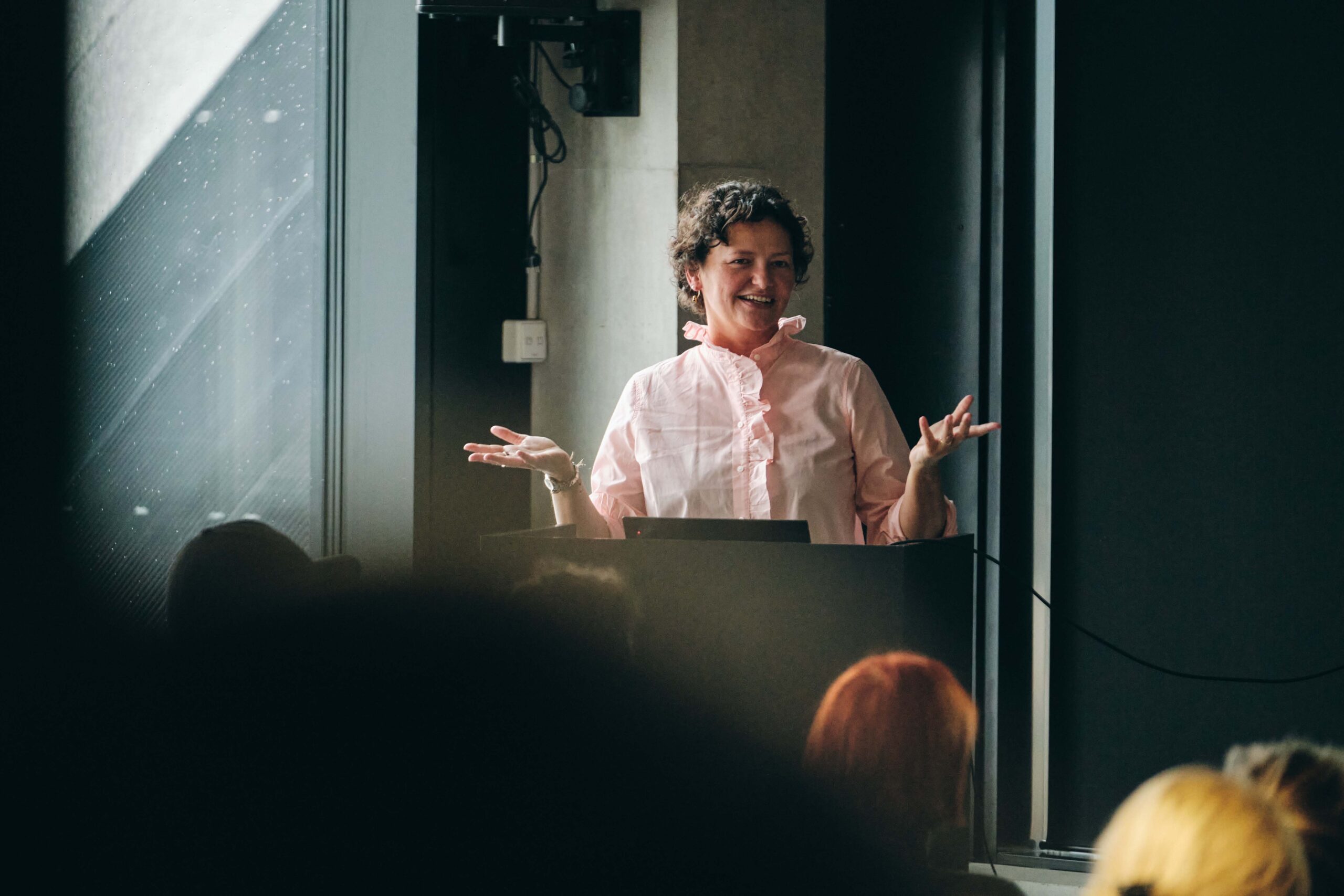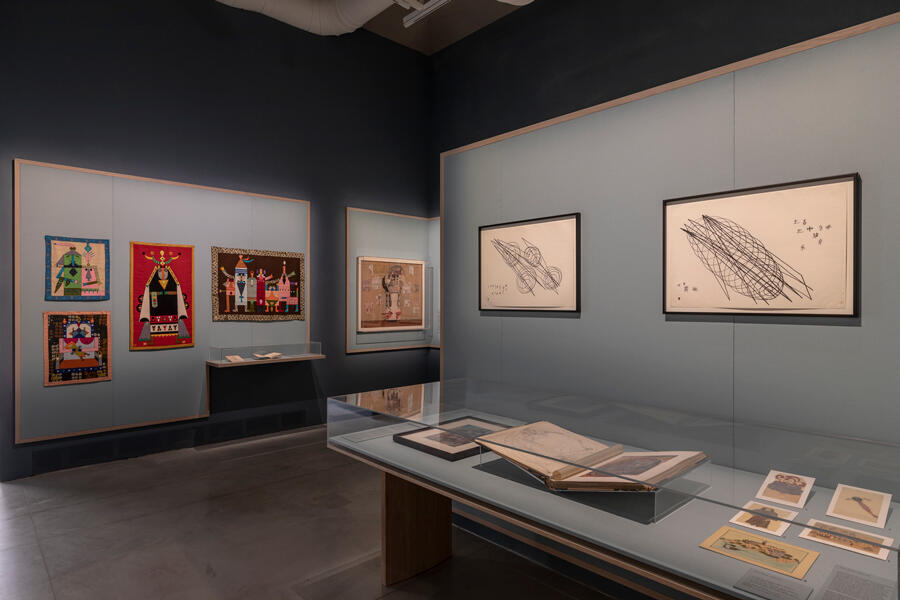
Although text is a crucial element in the process of exhibition making, especially for curators, it often seems to compete with the more visually appealing artworks. In recent years, a hunger for poetry and (narrative) fiction in exhibition environments has become evident. If done well, featuring multifaceted texts can provide an enriching experience for the viewer; if not, the visitor can easily get overwhelmed and annoyed in the accompanying word soup. It is not an easy task to welcome a variety of texts into art exhibitions and create texts that are accessible to viewers as well.
With Milk of Dreams, however, the main exhibition for the 59th Venice Biennale, the curator Cecilia Alemani managed to do both. The exhibition, borrowing its title from a short story by the painter and writer Leonora Carrington, was a remarkable exhibition in many ways, not least in its exploration of links between visual arts, literary works and poetry. So, when Alemani visited Tallinn in September, we sat down to speak about text and language in her work – the role of text, how to show it in an exhibition setting but also how (not) to read and write as a curator.
Keiu Krikmann: You have said that you live with books – you have a lot of books in your flat, and you appreciate books as physical printed matter. So, I’m wondering, what do you like to read, when do you like to read, and how do you like to read?
Cecilia Alemani: I live surrounded by books because my husband and I are both book collectors, and as part of our jobs, we receive an incredible number of books, which we love. For work, I mostly read art books, such as catalogues and theory books that I receive or buy; I also try to read every magazine that comes my way. I unfortunately read less literary works due to a lack of time, and if I have an hour in the evening before bed, I usually read something I need to read for my work. However, in the summer, I try to also read good literature. I try to read new Italian writers as much as I can. I still very much like to read books on paper, I’m not so used to reading ebooks, but I sometimes listen to audiobooks, especially when I’m in transit, like I was just listening to the last Omar Pahmuk book. But when I’m at home, I very much enjoy the physicality of the pages and the smell of the print; I’m very attached to it.
KK: Often, when I think about language, reading and writing, I remember a quote by Fred Moten: “I like to read, and I like to be involved in reading. And for me, writing is part of what it is to be involved in reading.” It’s beautiful how he connects the two. Curators inevitably have to be writers to some degree; they need to provide exhibitions with a lot of text – curatorial texts and conceptualisations of artworks. These texts can be seen as the prosthetics of an exhibition, a part of the infrastructure around the artworks. And when you curated Milk of Dreams, you also brought in a lot of literature. So, I’m wondering about the role of writing in your curatorial practice; how do you approach it? Is writing something you enjoy, is it difficult for you or maybe both?
CA: Unfortunately, for me writing is more challenging than enjoyable simply because of how my days are structured. I process thousands of emails in a day, and the writing I do in emails I don’t even consider writing; it’s so short and synthetic at this point. Also, as a non-native English speaker, your language gets very poor because you end up using a very limited vocabulary in digital communication. It is challenging for me to switch gears to write an essay and create that mental space where you can ignore your phone and emails and just dive in. I had a very academic background, a bachelor’s degree in philosophy, and a master’s in curatorial practice. The writing I was doing then was completely different – I had the headspace to study, to go to the library, to do the work. I think writing never gets easier for me; on the contrary, it’s painful and I do it because I have to; eventually, I enjoy it, but it’s not necessarily a very spontaneous process. I think it’s so difficult also because of the way we communicate these days.
The language gets very poor because we end up using a very limited vocabulary in digital communication.
KK: I think, as a curator, sometimes you prioritise artworks, and writing just slips in between things you really want to highlight. Regardless, in Venice, you brought a lot of literary works into the exhibition – you did this through references and titles, and you also had a chapter there that looked at language more directly through visual poetry, concrete poetry etc. Literary works can be an integral part of a curatorial practice – as part of the research, as part of how you come to the end result. Do you find it challenging to bring text to an exhibition space?
CA: No, for me, it was very enriching, and I thought it was also the case for the viewer. I spent a lot of time doing research for the historical capsules in the exhibition, and I didn’t want to focus necessarily only on artworks. When I was looking at the 1920s and 1930s and surrealism but also the 1960s, it seemed to me that the cultural field was much more unified, and the distinction between visual artists, writers and poets was less strict. It was more about the community of people coming together and working together, whereas I feel the fields are much more separated today and the communities much less fused together. So, it seemed quite obvious to include other parts of the cultural field, like poetry and literature in an exhibition that tried to look at the different kinds of cultural environments and contexts in which artists were working. Text was also an outlet for visual artists, so it felt very natural to include journals, poetry etc. I love it when I, and hopefully the viewers too, can learn something new from an exhibition.

KK: Sometimes I’m afraid that within the exhibition, the textual can’t compete with the visual; the way that the two grab the viewers' attention is very different. Were you not afraid of that a little bit, or was it just – it is what it is?
CA: Of course, I was not expecting someone to read a Joyce Mansour novel right there in the exhibition, but we could provide an easy way for the audience to write down the name of a poet they didn’t know and maybe buy their book in the bookshop. In a way, literature and poetry are much more approachable and easily accessible than a work of art that you usually get to see live only in an exhibition – a book is a less precious object; you can buy many different editions. In the exhibition, they were like hints or suggestions or a trampoline for people to get inspired. Maybe someone wanted to know more, for example, what The Crisis magazine was in the 1930s in New York, so they could go home and do some research. I think it’s a different kind of user experience. The moment of appreciating a painting or sculpture happens in the exhibition space, which is often highly choreographed, but when it comes to literature and the written word, it’s something you can take home with you.
KK: Definitely, text can create an atmosphere after the fact, in a way. You have also said that you always try to read what artists are writing – what have you encountered, and what do you look for? Is it more about reading things that would supplement artworks, or do you look for writing as artistic practice?
CA: I think it’s both – I don’t look for anything in particular, I’m just curious. I wish I had a lot of different talents. When I think about someone like Leonora Carrington, who is an incredible painter, her novels and writing are absolutely fabulous, and she could go from the medium of painting to the medium of writing in what seemed like a very fluid and easy way. What I truly appreciate is that she could use a completely different medium, the written word, to capture exactly the same atmosphere as in her paintings. She does it with the same levity, sense of humour, irony and sometimes darkness as in her paintings but using a different vocabulary. I’m not necessarily interested in artists writing about their own works, like Donald Judd explaining his sculptures – although his writing is incredible and I appreciate it in another way – but I am more fascinated when an artist finds a different outlet, like poetry or literature.
KK: I’d also like to talk a bit about the way we talk about art – a lot of people often make fun of international art English, which is a very specific type of language, jargon almost. It has become so ubiquitous and levelling, almost artificial, like a parasite that ends up creeping into your own language and thinking. As someone who works with a lot of different artists all over the world and gets to look into very different art scenes, have you noticed any difference in the way people in different parts of the world discuss their work?
CA: Of course, international art English is everywhere, and we are all complicit. I can’t tell you if it’s different in Latin America or Asia, but when it comes to exhibition language, it's universal; it's almost jargon as you say, and often feels empty. I don't know what the solution is. What I did in Venice, for example, we had artists check and approve every label we wrote. But it doesn’t mean artists don’t use that jargon. I want language to be accessible. It’s often about finding a compromise between what I want to say and what the artist wants to say. I also often try to push back against what the artist wants to say, trying to avoid what is evident anyway or references that are too obscure. So, I think our job as curators is to function as a link between the artwork and the general public and try to avoid jargon – dropping Deleuse and Guattari’s names in a label and so on, I think that is ridiculous. But when it comes to essays and the more sophisticated writing, what’s happening now is scary, it feels like all these texts are written by ChatGPT. I’m definitely curious to see what will happen to art writing because I think it’s not in a very strong position right now.
Our job as curators is to function as a link between the artwork and the general public and try to avoid jargon.
KK: And to conclude, despite all that, what are some of the books or writing or publishing practices that you’ve been excited about recently or you’ve enjoyed lately?
CA: The last book I read is by the Italian writer Antonio Scurati, M: Son of the Century, the third volume of Mussolini’s biography; the fourth one is forthcoming. It's a literary version of his life, and it's a scary read because right now in Italy we have a very right-wing government in power, and you can see so many of the tactics they are using now, a century later after fascism was born, deployed the same way. But Scurati is an amazing writer, and the series is definitely captivating.